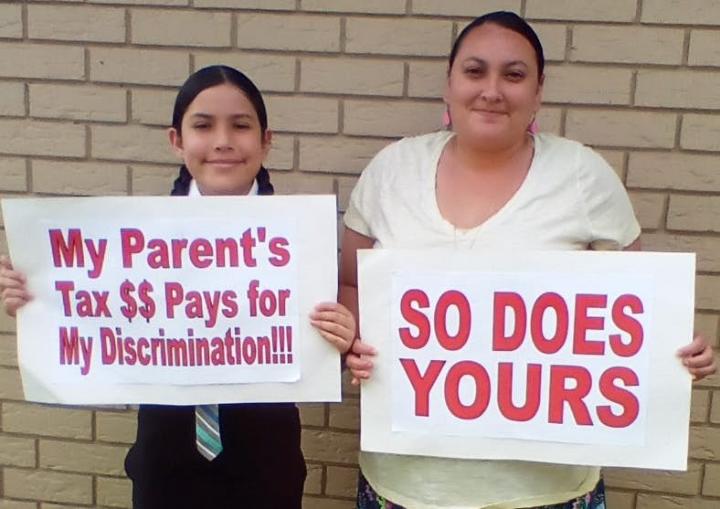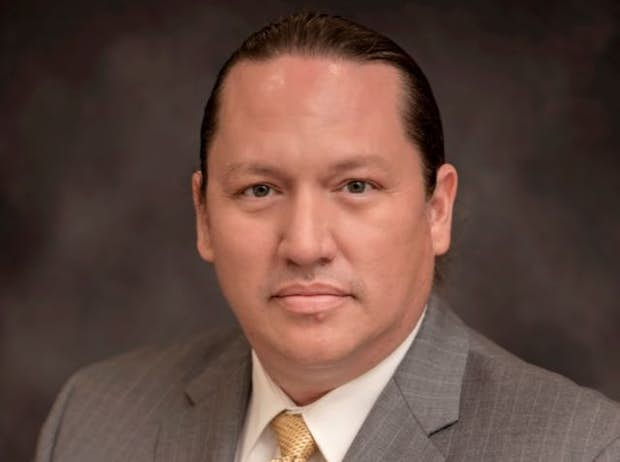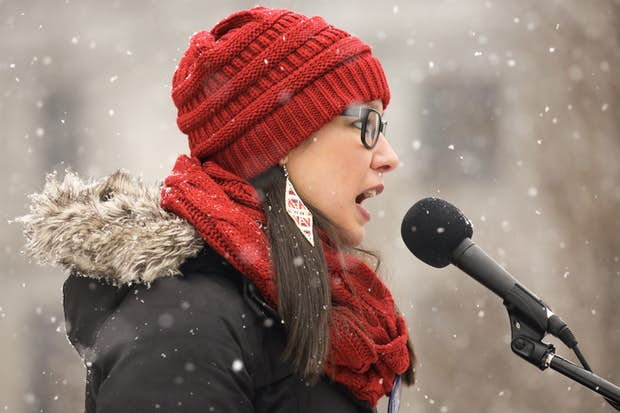 |
Canku Ota
|
 |
|
(Many Paths)
|
||
|
An Online Newsletter
Celebrating Native America
|
||
|
July 2020 - Volume 18
Number 7
|
||
|
|
||
|
High schools Are
Front Lines In Mascots Fight
|
||
|
by Mary Annette Pember
- Indian Country Today
|
||
While much publicity surrounds professional sports teams with Native American-themed mascots, the front lines of the battle lie in high schools. Ohio, a state with no federally recognized reservations, takes the lead at well over 100 such mascots, according to MascotDB, a database of over 50,000 high school, college and professional sports team names. According to the Dayton News, Ohio also has the greatest number of schools using the R-word as their mascot; among them is Wapakoneta High School, which has weathered many attempts to drop the R-word as its mascot. “It’s this weird hill that people are dying on here,” said Krissie Wells, 34, an alumni of Wapakoneta High School in the little town of Wapakoneta, about 180 miles southwest of Cleveland. Aaron Rex, superintendent of Wapakoneta schools, released a statement this week in response to the Washington NFL team’s name change and the school’s use of the R-word. “At Wapakoneta we have always believed that our representation of Native Americans and their history in our area has been done with a great deal of respect. Our community was once a place inhabited by many Indian tribes with the last being the Shawnee under the leadership of Chief Black Hoof. In the last few years we have redesigned our school logo and feel that it has been done keeping the idea of respect and history in mind. Wapakoneta has a great deal to be proud of, as you know. Native American history is one piece of what makes our town one of the best small towns in Ohio.”
Ben Barnes, chief of the Shawnee Tribe of Oklahoma, whose people were removed from the area around Wapakoneta in 1831, sent a tweet responding to Rex’s statement published in the Lima News. “You said, ‘Our community was once a place inhabited by many Indian tribes with the last being the Shawnee under the leadership of Chief Black Hoof.’ The office of Chief of the Wapakoneta Shawnee is now me. Ask us our opinion 1st,” he wrote. Barnes has not yet received a response from Wapakoneta school leadership.
“How can they say they’re honoring us if they won’t even speak to us?” Barnes asked. In a statement describing the tribe’s position on mascots and the Washington football team’s decision to drop use of the R-word, Barnes wrote, “We are not mascots. We are living cultures and languages with histories going back thousands of years. Our stories are a thousand-fold, filled with wondrous stories of our ancestors and our relationship to the land. It is in this way we want people to know us, not as an emblem on a hat.” “Wapakoneta is holy ground for us; it is where Chief Black Hoof died,” Barnes said.
Chief Black Hoof supported peace with the Americans and represented the Shawnees at the signing of the 1795 Treaty of Greenville in which the Shawnee and other tribes relinquished claim to lands south and east of a boundary near the mouth of the Cuyahoga River. Black Hoof opposed the tribe’s forced removal in 1831 from lands surrounding Wapakoneta to Kansas and later to Oklahoma as part of the 1830 Indian Removal Act. He died in Wapakoneta before the removal order was carried out. Margaret Hicks and her son Jaxson “Biscuit” Hicks, 11, of the Shawnee tribe, are descendants of Chief Black Hoof. They live in Tulsa, Oklahoma. “The R-word is an insult; using it to honor us is actually like celebrating our removal and all the horrible things that happened to our people,” Margaret Hicks said.Jaxson recently spoke to members of the Union public school board in Tulsa about their use of the R-word for a team mascot. Union public schools formed a committee including Native representatives to review their use of the mascot. “I wouldn’t want to buy school merch with the R-word; I wouldn’t sing the school song. I would feel ashamed; the R word is wrong,” Jaxson said. Chief Black Hoof was Jaxson’s great, great, great, great grandfather. Black Hoof descendants maintain a family Facebook page to stay in touch, according to Margaret Hicks.“We had a virtual discussion about Wapakoneta’s claims that they are honoring us. One of our elders said, ‘They obviously don’t care about us since they’ve never bothered to reach out to us,’” Hicks said. Schools are an essential part of the public discussion surrounding the use of Native mascots, according to Cynthia Connolly, citizen of the Little Traverse Bay Bands of Odawa Indians. Connolly lives in Cleveland and is on the board of the Lake Erie Native American Council. The Council has joined with the Committee of 500 Years of Dignity and Resistance and the American Indian Movement of Ohio to create the Cleveland Indigenous Coalition. The coalition is calling for the Cleveland baseball team to drop its mascot and is reaching out to schools to follow suit. “Schools think they are honoring the memory of Native people and educating the community through the use of mascots,” she said.
The practice, however, reflects the woefully inadequate curriculum regarding Native Americans taught in most of the country’s K-12 schools, according to Connolly. “According to Illuminative’s ‘Becoming Visible’ report, 87 percent of state level history standards fail to cover Native people’s history in a post-1900 context,” she said. Illuminative is a Native-led nonprofit initiative designed to increase the visibility of — and challenge the negative narrative about — Native nations people.“We just disappear in school curriculum after 1900; we are never talked about through a modern lens,” Connolly said. Curriculum is at the heart of the fight, she said. “They will never honor or adequately represent over 500 federally recognized tribes through the use of a mascot.” The U.S. Commission on Civil Rights agrees. On Friday, organization members passed a resolution that reads in part, “Native mascots inhibit accurate understanding of experiences of Native Americans and encourages biases against them, contrary to their rich and diverse history.” Cleveland Indigenous Coalition members are working to get support from community organizations and the Cleveland City Council in calling for the Cleveland Indians baseball team to drop its mascot. Connolly notes that the Cleveland City Council recently voted to declare racism a public health crisis. “If racism is a public health crisis, they need to get serious about honoring that legislation and support a name change for the baseball team,” she said.The Cleveland baseball team released a statement July 4 saying it is in discussions about changing the mascot name. Schools are beginning to reach out to the coalition for advice regarding their Native mascots, according to Connolly. “Professional teams need to recognize the type of influence they have in the larger community. By retaining these names, they are condoning their use, creating a negative atmosphere in schools and undermining the educational experience for both Native and non-Native students,” Connolly said. Members of the Wapakoneta community have been arguing about the appropriateness of the school mascot for years, according to Wells.“Someone posted Chief Barne’s tweet on the community Facebook page; people questioned if he really represented the tribe. They basically just doubled down on their insistence that the R-word honors the tribe; they eventually deleted his tweet,” she said. Indian Country Today sent an email to Wapakoneta school superintendent Rex asking if he or the school board is interested in speaking with Chief Barnes or Margaret and Jaxson Hicks about the future of the school’s mascot.
Rex declined to be interviewed on the phone but sent an email. He wrote in part, “In a way to recognize and honor the Indian history in our area, the forefathers of Wapakoneta created a mascot that would stand for pride, honor and courage. These are all qualities that someone would want in a person who would graduate from our school district. Our town has always done its best to pay homage to the Native American culture and influence that makes our town and our school district what they are today.” Neither the Cleveland baseball team nor the Wapakoneta school district have reached out to members of the Native American community, according to Connolly, Barnes and Hicks. “I would love to have a meaningful conversation with them; we could do a Zoom call. I’m a level-headed person, and I think we’d come to a wonderful understanding,” Hicks said. For supporters of the Wapakoneta mascot, it’s all about nostalgia, according to Wells. “They’ve been ignoring calls to drop the name for decades. I think the school board just needs to do what’s right and change the name,” she said. But what are the possible alternatives? She noted that astronaut Neil Armstrong was born in Wapakoneta; Armstrong was the first man to walk on the moon during the 1969 Apollo 11 Mission. “People here are crazy proud of Neil Armstrong,” she said. “They could change the name to the moon walkers; how cool would that be?” Wells said.
Mary Annette Pember, a citizen of the Red Cliff Ojibwe tribe, is a national correspondent for Indian Country Today.
IllumiNative |
|||||||||||||
|
|
|
|
||
|
|
||
| Canku Ota is a free Newsletter celebrating Native America, its traditions and accomplishments . We do not provide subscriber or visitor names to anyone. Some articles presented in Canku Ota may contain copyright material. We have received appropriate permissions for republishing any articles. Material appearing here is distributed without profit or monetary gain to those who have expressed an interest. This is in accordance with Title 17 U.S.C. Section 107. | ||
|
Canku Ota is a copyright ©
2000 - 2020 of Vicki Williams Barry and Paul Barry.
|
||
 |
 |
|
|
The "Canku
Ota - A Newsletter Celebrating Native America" web site and
its design is the
|
||
|
Copyright ©
1999 - 2020 of Paul C. Barry.
|
||
|
All Rights Reserved.
|
||






